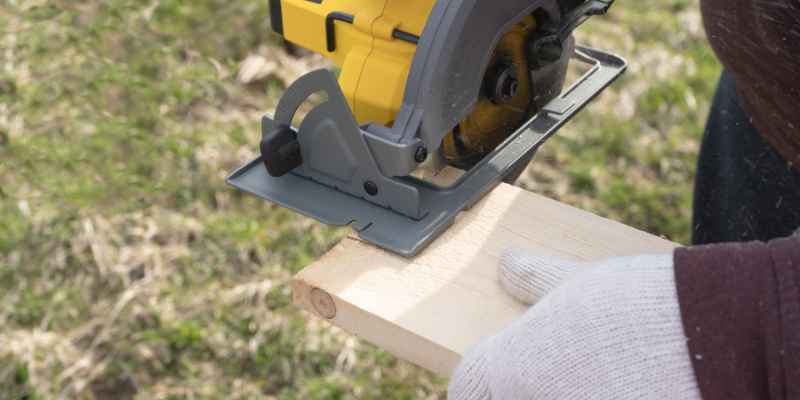A Skill Saw is not the same as a Circular Saw. Both saws have similar functionalities, but they differ in terms of technical aspects and design.
Skill Saw, also known as a worm drive saw, has the blade located on the left side of the motor, while a Circular Saw, also referred to as a sidewinder, has the blade aligned to the right side of the motor.
Additionally, Skill Saws tend to be heavier and more powerful, suitable for heavy-duty tasks, while Circular Saws are lighter and more commonly used for general woodworking. Overall, the choice between the two depends on the specific application and personal preference of the user. It is important to understand the differences to ensure the right tool is selected for the job.
What Is A Skill Saw?
A Skill Saw is a type of circular saw that is known for its versatility and ease of use. It is a power tool used for making straight cuts in various materials such as wood, metal, or plastic.
Origin And Definition
The term Skill Saw originally referred to the Skilsaw brand, which was the first to introduce portable circular saws to the market in 1924. Over time, the term has become synonymous with circular saws in general.
Features And Uses
A typical Skill Saw is equipped with a circular blade that spins at high speed to cut through different materials. It is commonly used in woodworking, carpentry, and construction for tasks such as cutting lumber, plywood, and metal sheets.

What Is A Circular Saw?
A circular saw is a versatile power tool used for cutting various materials with a rotating blade. Although the terms are often used interchangeably, a skill saw refers specifically to a brand of circular saw produced by Skil Corporation.
A circular saw is a versatile power tool that is widely used in construction and carpentry. As the name suggests, it features a circular blade that spins at high speeds, making it ideal for making straight cuts through various materials such as wood, plastic, and metal. In this section, we will explore the origin and definition of this essential tool, as well as its features and common uses.
Origin And Definition
The circular saw has a fascinating history that dates back to the late 18th century. It was invented by a Dutchman named Cornelis Corneliszoon van Uitgeest in the year 1597. Originally, it was a cumbersome machine powered by a windmill, but over time, advancements in technology led to the development of smaller, more portable versions.
Today, the circular saw is a compact and efficient handheld tool that has become a staple in almost every woodworking shop and construction site. Its primary function remains the same—to make precise and accurate cuts—but the design and features have evolved greatly.
Features And Uses
A circular saw typically consists of a motor, a circular blade, a handle, and a guard to protect the user from the sharp rotating blade. It can be corded, powered by electricity, or cordless, powered by a battery. The blade itself varies in size and tooth configuration, allowing for different cutting depths and purposes.
Circular saws are used in a wide range of applications. Whether you are a professional carpenter or a DIY enthusiast, this tool can be highly beneficial. Some common uses include:
- Cutting lumber for construction projects such as framing and decking.
- Trimming doors, windows, and baseboards for precise fitment.
- Creating crosscuts or rip cuts in plywood and other sheet materials.
- Building furniture pieces like cabinets, shelves, and tables.
- Performing renovation tasks, such as cutting through drywall or removing old flooring.
In summary, a circular saw is an indispensable tool that allows for efficient and accurate cutting in various woodworking and construction projects. Its origin can be traced back centuries ago, and with advancements in technology, it has become an essential part of any handyman’s toolkit. By understanding its features and uses, you can harness the power of this versatile saw and unleash your creativity in the world of carpentry and DIY projects.
Key Differences Between Skill Saw And Circular Saw
The primary difference between a Skill Saw and a circular saw lies in the brand name. Skillsaw is a specific brand, while a circular saw is a more generalized term for the tool. Both tools function similarly, but the key differences lay in the specific features and design aspects offered by each brand.
Design And Ergonomics
When it comes to the design and ergonomics, there are some noticeable differences between a Skill Saw and a Circular Saw.
A Skill Saw, also known as a sidewinder, is named after its manufacturer and is designed with the motor positioned alongside the blade. This design allows for a more compact and lightweight tool, making it easier to handle and maneuver during tasks. The handle of a Skill Saw is usually positioned towards the rear, providing a comfortable grip and improved control.
On the other hand, a Circular Saw is designed with the motor positioned in line with the blade, creating a more direct power transfer. The handle of a Circular Saw is typically located at the top, allowing for a two-handed grip that promotes stability and accuracy during cutting.
Blade Size And Type
Blade size and type are important considerations when choosing between a Skill Saw and a Circular Saw.
A Skill Saw commonly has a smaller blade size, typically ranging from 6.5 to 7.25 inches in diameter. This smaller blade size makes it suitable for lighter cutting tasks and provides greater control and precision.
In contrast, a Circular Saw is available in larger blade sizes, ranging from 7.25 to 10.25 inches or more. These larger blades are ideal for heavy-duty cutting, such as working with thick lumber or sheet materials.
It’s worth noting that both Skill Saws and Circular Saws can accommodate different blade types, including ones specifically designed for cutting through wood, metal, or other materials.
Cutting Abilities
While both Skill Saw and Circular Saw are versatile cutting tools, they have slightly different cutting abilities.
A Skill Saw excels in making crosscuts and rip cuts in wood, making it a popular choice for carpentry and framing tasks. Its smaller blade size provides better control for precise cutting, making it an ideal tool for detailed woodworking projects.
On the other hand, a Circular Saw is known for its ability to handle tougher cutting tasks. With its larger blade size and more powerful motor, it can cut through thick materials like plywood, lumber, and even masonry.
Both saws have their own strengths and limitations, so it’s important to consider the specific cutting needs to determine which tool would be the most suitable for the job at hand.
To summarize, the key differences between a Skill Saw and a Circular Saw can be found in their design and ergonomics, blade size and type, as well as their cutting abilities. Understanding these differences will help you make an informed decision when it comes to selecting the right tool for your specific cutting needs.
Commonalities Between Skill Saw And Circular Saw
A skill saw and a circular saw are often used interchangeably because of their similar appearance and functionality. While they have unique features, they share commonalities that make them comparable in certain aspects. Understanding these similarities can help in making informed decisions when choosing the right tool for your woodworking projects. Let’s explore the commonalities between a skill saw and a circular saw.
Power Source
Both the skill saw and circular saw are powered by electricity, utilizing a power cord that connects to a power outlet. This mains-powered operation provides consistent and reliable power, making them suitable for a wide range of cutting tasks.
Safety Features
Both saws are equipped with safety features designed to minimize the risk of accidents during operation. These features may include blade guards, kickback prevention mechanisms, and ergonomic handles to ensure user safety while handling the tool. Safety is a top priority in the design of both skill saws and circular saws.

Which One Should You Choose?
Are you stuck between choosing a skill saw and a circular saw? Learn the key differences and decide which one suits your needs best. Avoid confusion and make an informed decision.
Project Requirements
If you are embarking on a woodworking project, whether it’s building a deck, constructing furniture, or even making intricate craft pieces, having the right tools is crucial to achieving professional-level results. When it comes to choosing between a skill saw and a circular saw, understanding your project requirements should be your primary consideration.
- Identify the specific tasks you need to accomplish.
- Determine the type and thickness of materials you will be working with.
- Consider the precision and accuracy needed for your project.
By assessing your project requirements, you can make an informed decision and select the saw that will best meet your needs.
Personal Comfort
Working with power tools can be physically demanding, so considering your personal comfort is essential. Both skill saws and circular saws have their own advantages in terms of ergonomics and ease of use.
A skill saw, also known as a sidewinder, is typically lighter and more compact, allowing for better maneuverability in tight spaces. Its blade is located on the same side as the motor, which provides a clear line of sight during cutting. This can be advantageous when working with intricate designs or making precise cuts.
A circular saw, on the other hand, is bulkier and generally heavier. Its blade is located on the opposite side of the motor, meaning you might need to lean over the tool for a clear view of the cutting line. While this might not be an issue for shorter tasks, longer or more extensive projects could strain your posture and lead to fatigue.
Consider your physical capabilities, the duration of your project, and your comfort while operating the tool to ensure a comfortable and enjoyable woodworking experience.
Budget Considerations
Finally, while it’s important to invest in quality tools that will deliver excellent results, budget considerations also play a significant role in your decision-making process. Skill saws and circular saws vary in terms of cost, features, and brand reputation.
Generally, skill saws are the more affordable option, making them an attractive choice for beginners or those on a tight budget. However, it’s important to balance cost with quality, as a cheaper saw may lack durability or certain features that could impact its performance.
Circular saws, on the other hand, tend to be pricier, but they also offer a wider range of options and capabilities. If you anticipate using the tool frequently or tackling more demanding projects, investing in a higher-quality circular saw might be a wise long-term choice.
Consider your budget, the frequency of use, and the value you expect to get from the tool to make an informed decision that suits both your needs and your wallet.
Conclusion
To sum up, while both a skill saw and a circular saw share similar functions, there are some key distinctions between the two. Understanding these differences will help you choose the right tool for your specific projects. Whether it’s precision cutting or more heavy-duty tasks, having the knowledge to differentiate between the two will empower you to make informed decisions.


